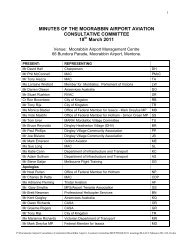Circuit Training at Moorabbin Airport Circuit Training at Moorabbin ...
Circuit Training at Moorabbin Airport Circuit Training at Moorabbin ...
Circuit Training at Moorabbin Airport Circuit Training at Moorabbin ...
You also want an ePaper? Increase the reach of your titles
YUMPU automatically turns print PDFs into web optimized ePapers that Google loves.
City of Kingston:<br />
A design<strong>at</strong>ed flight p<strong>at</strong>h for helicopters wishing to access the airport th<strong>at</strong> minimizes low<br />
altitude flying over residential areas is supported<br />
City of Gre<strong>at</strong>er Dandenong:<br />
The City of Gre<strong>at</strong>er Dandenong made an identical submission to the City of Kingston<br />
Dingley Village Community Associ<strong>at</strong>ion:<br />
Although the majority of noise caused by helicopters over Dingley Village is caused by<br />
training circuits, DVCA would support this move as a step towards reducing total noise.<br />
MARA:<br />
Suggest helicopters follow the major road network, not as now which appears to be the<br />
shorter route from A to B. Consider flight p<strong>at</strong>hs along Boundary Rd, Nepean Highway,<br />
freeways(eg: Eastlink) and Cheltenham Rd.<br />
9.2.5. Can the circuit height be raised ‐ and if so to wh<strong>at</strong> altitude?<br />
The circuit altitude is 1,000 feet and this is a rel<strong>at</strong>ively standard altitude across the country.<br />
Aircraft gaining height are for the most part on full throttle and will only throttle back when<br />
such altitude is <strong>at</strong>tained. The speed with which they <strong>at</strong>tain this altitude is geared to their<br />
performance. A Cessna 182 will reach 1,000 feet much more quickly then a Cessna 152 basic<br />
trainer. Can the altitude be raised to, say, 1,500 feet?<br />
The logic behind this is th<strong>at</strong> aircraft make less noise <strong>at</strong> 1,500 feet especially when throttled<br />
back. However no evidence exists to support or disprove this contention.<br />
RVAC:<br />
Increasing the height of the circuit will only prolong the time taken to reach 1000ft and<br />
therefore increase noise issues. Practicing non‐standard circuits’ p<strong>at</strong>terns is not conducive to<br />
flight training. Since <strong>Moorabbin</strong> is a primary training airfield it of utmost importance th<strong>at</strong><br />
training is standardised here first.<br />
MFT:<br />
As per item 1.2.2, there is no neg<strong>at</strong>ive cost impact but I believe there is a safety impact. The<br />
skills taught via the standard circuit p<strong>at</strong>tern provide important visual cues in the circuit th<strong>at</strong><br />
can be applied to an in‐circuit emergency procedure. It is imper<strong>at</strong>ive th<strong>at</strong> the circuit taught <strong>at</strong><br />
<strong>Moorabbin</strong> be a standard circuit p<strong>at</strong>tern th<strong>at</strong> can be applied <strong>at</strong> all aerodromes.<br />
Oxford Avi<strong>at</strong>ion Academy:<br />
Raising the circuit height will cre<strong>at</strong>e oper<strong>at</strong>ional difficulties. With a higher circuit, days of<br />
lower cloud base will severely restrict the availability of circuit training. It also means th<strong>at</strong><br />
overflying aircraft will have to be 500ft higher again which may be unavailable due cloud.<br />
Climbing to and then descending from a higher circuit altitude, will add almost two minutes<br />
to a circuit p<strong>at</strong>tern. This will reduce the number of circuits possible in a typical one hour<br />
lesson, making training less efficient and probably necessit<strong>at</strong>ing additional circuit lessons.<br />
38




